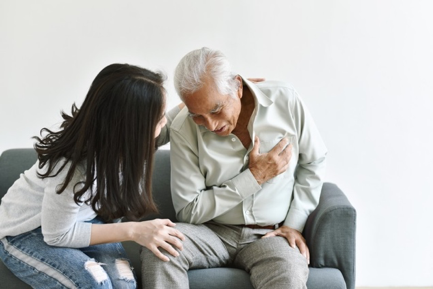
While people tend to use the terms interchangeably, going into cardiac arrest and having a heart attack are not synonymous. Their difference can be best explained in terms of a house: cardiac arrest is an “electrical” problem, while a heart attack is a “plumbing” problem.
Cardiac arrest occurs because of complications with the heart’s regular rhythm; a heart attack is caused by an interruption in normal blood flow. Note that while heart attacks do not cause cardiac arrest, having a heart attack does increase an individual’s chance for sudden cardiac arrest.
It’s important to understand the difference so you know the appropriate way to react if you or someone around you is experiencing the symptoms of either cardiac arrest or a heart attack—getting the victim help as soon as possible is vital. During cardiac arrest especially, every minute counts. Survival rates for people who experience cardiac arrest outside a hospital is just 10%, but that chance increases to 90% if the victim receives CPR and AED treatment in the minutes following.
Heart Attacks
Heart attacks are caused when blood flow in the coronary arteries is impeded by plaque. With oxygenated blood struggling to reach the heart, parts of the muscle are damaged and begin to die.
Victims of heart attacks typically remain conscious, as blood is still reaching their brain. Symptoms can occur minutes to hours before, with the most common being chest pain, sometimes extending to the arms, back, stomach, neck, or jaw. Other signs include shortness of breath, cold sweats, nausea, and weakness, though symptoms can differ between men and women.
If you or someone nearby is experiencing symptoms, it’s best to call 911, even if you’re not sure a heart attack is to blame. If the victim can and is not allergic, they should chew aspirin to improve blood flow and should take nitroglycerin only if prescribed. The victim should rest and try to remain calm until paramedics arrive. If they lose consciousness, begin CPR right away.
Cardiac Arrest
Sudden cardiac arrest occurs because of a disruption in the heart’s electrical system, which causes a cardiac arrhythmia—an irregular heartbeat. Some types of arrhythmias are harmless, while others can stop the function of the heart entirely, preventing blood from flowing to the rest of the body—this is cardiac arrest.
Certain heart conditions, like coronary artery disease or congenital heart defects, can increase the chance cardiac arrest. However, the unfortunate nature of sudden cardiac arrest is that it is often unpredictable, occurring in people with no history of heart disease.
There is usually little warning of cardiac arrest. Because their blood flow has stopped, the victim quickly loses consciousness and stops breathing, collapsing suddenly with no pulse; if they remain conscious, they will typically be struggling to breathe.
However, some victims experience signs of cardiac arrest before it happens, including chest pain, dizziness, shortness of breath, and feeling generally unwell, sometimes with flu-like symptoms. Because these signs can seem minor and be explained by multiple other causes, it’s important to know and factor in your family’s history of heart disease.
If someone around you goes into cardiac arrest, immediately call 911 and begin CPR. Use an AED if one is available; if possible, send someone else to get it so you can continue compressions.
Whether facing a heart attack or sudden cardiac arrest, CPR is an extremely important skill to have. Specialized Health and Safety offers comprehensive classes for CPR certification, AED instruction, and more. Visit us online to schedule or view our full class list.

